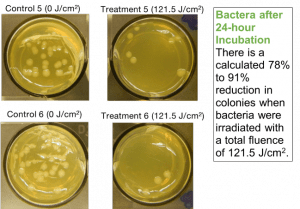From working with high school teachers in the Research Experience for Teachers program to teaching elementary school students the basics of physics in his Down to Earth Experimental Physics program in Shorewood, UWM Physics Professor Vali Raicu has turned his outreach to students and teachers of all levels into a science.
In November 2012, the Raicu Research Group reached out a bit more. The Group was in the early stages of a joint project with Dr. Chukuka Enwemeka (UWM College of Health Sciences) when Nicolet High School junior Grant Hussey approached Raicu about possible research opportunities that he would be able to develop into a project for a science fair competition. The joint project was a perfect fit for Hussey.
In early 2013, Hussey joined Raicu and Enwemeka’s research team, which included Drs. Gabriel Biener (Physics), Violet Bumah and Daniela Masson-Meyers (College of Health Sciences), to research a method of eradicating bacteria using blue light. Methicillin-resistant Staphylococcus aureus, or MRSA as it is more commonly known, is a bacterium that has become resistant to common antibiotics used to treat infections. MRSA may remain confined to the skin but can also cause potentially life-threatening infections. Because of bacteria’s resistance to antibiotics, new therapies to eradicate it are of great interest in the healthcare community.
Hussey’s project proposed that irradiation by blue laser light may lead to bacterial eradication and researched a novel method to study the biological processes of the cells after irradiation. He focused on identifying the correlation between the changes in metabolic activities induced by exposure to blue laser light. Hussey also examined the relative concentration of the molecules nicotinamide adenine dinucleotide (NADH) and flavin adenine dinucleotide (FAD) within the cell. The ratio, known as the “redox ratio,” of these two molecules could indicate the vitality of the cells, or how well they’re able to function, after the blue laser treatment. In addition, since the NADH and FAD molecules are naturally fluorescent, the team speculated that they could measure fluorescence intensity by using the two-photon, spectrally resolved microscopy system developed in Raicu’s lab to determine their concentrations within the cell, and use that to calculate the redox ratio.
To start, Hussey performed an extensive literature search focusing on the protocols used to prepare the bacteria samples, finding the biological agent responsible for the self-destruction of the bacteria when exposed various types of light sources, understanding methods for monitoring vitality of the bacteria and discovery of the physical and biological processes that are triggered as a result of illumination.
The team irradiated multiple MRSA bacteria samples with the  blue laser in several different experiments, each controlling for various parameters like exposure time and illumination power. They then tested the eradication level of the bacteria by counting the number of bacterial colonies in the samples. The post-irradiation samples revealed a calculated 78-91 percent reduction in bacteria colonies compared to control samples that were not irradiated.
blue laser in several different experiments, each controlling for various parameters like exposure time and illumination power. They then tested the eradication level of the bacteria by counting the number of bacterial colonies in the samples. The post-irradiation samples revealed a calculated 78-91 percent reduction in bacteria colonies compared to control samples that were not irradiated.
To study what changes, if any, arose in the molecular composition of the bacteria as a result of the blue laser irradiation, Hussey capitalized on the fluorescent properties of NADH and FAD and imaged the emission spectrum of these two molecules at several time intervals using the OptiMiS imaging system, a laser-scanning microscope system developed by Raicu’s group.
Those images were analyzed using special “spectral unmixing” software to split the emission intensity into the colors corresponding to FAD and NADH. Hussey calculated the ratio of  FAD to NADH present at various times on the control samples and the irradiated samples. The results indicated the FAD/NADH redox ratios stay the same in the control samples, but there was a significant increase in irradiated bacteria’s FAD/NADH redox ratios, which could mean that the cell was fighting off the effects of the blue laser. An increasing FAD/NADH ratio suggests a correlation between irradiation with blue laser and a reduction in a cell’s ability to function.
FAD to NADH present at various times on the control samples and the irradiated samples. The results indicated the FAD/NADH redox ratios stay the same in the control samples, but there was a significant increase in irradiated bacteria’s FAD/NADH redox ratios, which could mean that the cell was fighting off the effects of the blue laser. An increasing FAD/NADH ratio suggests a correlation between irradiation with blue laser and a reduction in a cell’s ability to function.
Hussey presented his work in a science fair competition at Nicolet High School in late February 2014 where he was awarded second place. As a top-three finisher at Nicolet, Hussey was invited to present at the Intel International Science and Engineering Fair competition in Los Angeles in May 2014. The Intel ISEF is the world’s largest high school science research competition.
This research experience has had a profound effect on Hussey’s plans for the future. As a high school senior, he’s in the thick of the college selection process. His long-term goal is to major in physics and then continue his education to a PhD in a yet-to-be-determined physics specialty. He’s seriously considering biophysics as a result of his experience with Raicu’s research group.
“Working with Raicu Lab has influenced my future by motivating me even further to pursue a career in science,” Hussey said. “As a high school student, I’m getting hands-on lab experience, researching what very well could be someone’s doctoral thesis. Doing such realistic research lets me step back from the non-stop due dates of high school to see how what I am learning might actually apply to my career. Seeing my hard work in high school not be in vain makes me keep trying my best.”
